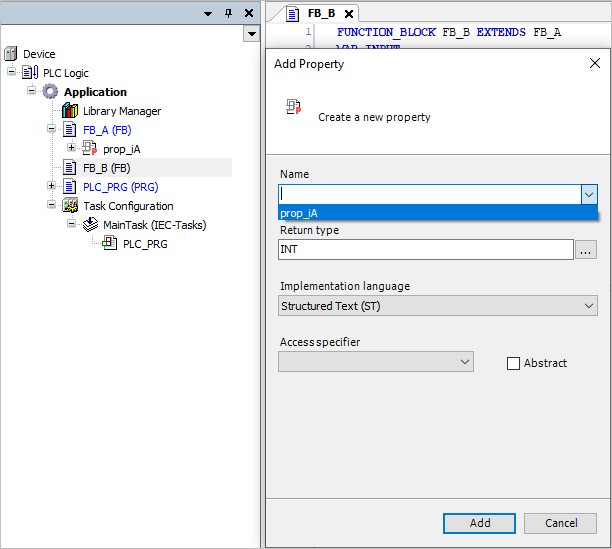Symbol: 
Keyword: METHOD
Methods are an extension of the IEC 61131-3 standard and a tool for object-oriented programming which is used for data encapsulation. A method contains a declaration and an implementation. However, unlike a function, a method is not an independent POU, and it is subordinated to a function block or program. A method can access all valid variables of the superordinate POU.
You can use interfaces for the organization of methods.
You can add a method below a program or a function block. Click “Project Add Object Method” to open the “Add Method” dialog.
Declaration
-
The variables of a method contain temporary data that are valid only during the execution of the method (stack variables). All variables that are declared and implemented in a method are reinitialized each time the method is called.
-
Like functions, methods can have additional outputs. You have to assign these additional outputs in the method call.
-
Depending on the declared access specifier, a method can be called only within its own namespace (
INTERNAL), only within its own POU and its derivatives (PROTECTED), or only within its own POU (PRIVATE). ForPUBLIC, the method can be called from anywhere.
Interface methods can have declared input, output, and VAR_IN_OUT variables, but do not contain an implementation.
See also
Implementation
-
Access to function block instances or program variables is allowed in the implementation of the method.
-
The
THISpointer allows for access to its own function block instance. Therefore, the pointer is allowed only in methods that are assigned to a function block. -
A method cannot access
VAR_TEMPvariables of the function block. -
A method can call itself recursively.




NOTICE

When you copy a method below a POU and add it below an interface, or move the method there, the contained implementation is removed automatically.
Calling a method
Syntax for calls:
<return value variable> := <POU name> . <method name> ( <method input name> := <variable name> (, <further method input name> := <variable name> )* );
For the method call, you assign transfer parameters to the input variables of the method. Respect the declaration when doing this. It is enough to specify the names of the input variables without paying attention to their order in the declaration.
Example
Declaration
METHOD PUBLIC DoIt : BOOL VAR_INPUT iInput_1 : DWORD; iInput_2 : DWORD; sInput_3 : STRING(12); END_VAR
Call
bFinishedMethod := fbInstance.DoIt(sInput_3 := 'Hello World ', iInput_2 := 16#FFFF, iInput_1 := 16);
When the method is called, the return value of the method is assigned, for example, to variables declared locally. When you omit the names of the input variables, you have to pay attention to the declaration order.
Example
Declaration
METHOD PUBLIC DoIt : BOOL VAR_INPUT iInput_1 : DWORD; iInput_2 : DWORD; sInput_3 : STRING(12); END_VAR
Call
bFinishedMethod := fbInstance.DoIt( 16, 16#FFFF,'Hello World ');
Recursive method call
Within the implementation, a method can call itself, either directly by means of the
THIS pointer, or by means of a local variable for the assigned function block.
-
THIS^. <method name> ( <parameter transfer of all input and output variables> )Direct call of the relevant function block instance with the
THISpointer -
VAR fb_Temp : <function block name>; END_VARCall by means of a local variable of the method that temporarily instantiates the relevant function block
A compiler warning is issued for a recursive call. If the method is provided with
the pragma {attribute 'estimated-stack-usage' := '<sstimated_stack_size_in_bytes>'}, then the compiler warning is suppressed. For an implementation example, see the
"Attribute 'estimated-stack-usage'" chapter.
To call methods recursively, it is not enough to specify only the method name. If only the method name is specified, then a compiler error is issued: “Program name, function or function block instance expected instead of”
Special methods of a function block
|
|
Declarations automatically implicit, but explicit declaration also possible Contains initialization code for the function block, as is defined in the declaration part of the function block |
|
|
Explicit declaration is necessary. Call after the instance of the function block was copied (as during an online change). It reinitializes the new instance module. |
|
|
Explicit declaration is necessary. Call for each instance of the function block before a new download or a reset or during an online change for all shifted or deleted instances. |
|
Properties |
Provides |
Dialog 'Add Method'
Function: Defines a method below the selected POU when the dialog is closed.
Call: Menu bar: “Project Add Object Method”; context menu
Requirement: A program (PRG) or a function block (FUNCTION_BLOCK) is selected in the “POUs” view or the “Devices” view.
The interface of a method inserted below a basic function block is copied when a method with the same name is inserted below a derived function block.
|
“Name” |
Example: The standard methods |
|
“Return type” |
Default data type or structured data type of return value Example: |
|
“Implementation language” |
Example: “Structured Text (ST)” |
|
“Access specifier” |
Controls access to data.
|
|
“Abstract” |
|
|
“Add” |
Adds a new method below the selected object. |
Input support when generating inheriting POUs
When you doing object-oriented programming and using the inheritance (keyword EXTENDS) of POUs, you can get support as follows:
When you insert an action, a property, a method, or a transition below a POU derived from a base POU, the “Add …” dialog opens. Then the input field for the name extends to a list box. The list box contains a valid selection from the actions, properties, methods, or transitions available in the base POU. Now you can, for example, easily accept a method of the base POU and then adapt it to the derived function of the POU.
Methods and properties with the access modifier PRIVATE are not listed here because they are also not inherited. Methods and properties with
the access modifier PUBLIC automatically get a blank access modifier field when accepting into the derived POU,
which means the same thing functionally.
Example








 : Identifies that the method does not have an implementation and the implementation
is provided by the derived FB
: Identifies that the method does not have an implementation and the implementation
is provided by the derived FB